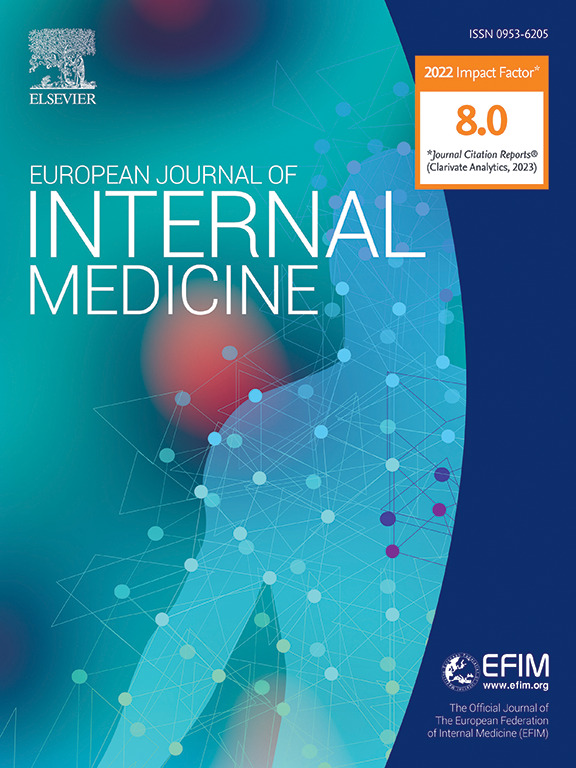Prognostic value of N-terminal prohormone B-type natriuretic peptide modified by renal function in patients with acute heart failure
IF 6.1
2区 医学
Q1 MEDICINE, GENERAL & INTERNAL
引用次数: 0
Abstract
Introduction
It remains unclear whether renal function and follow-up duration impact the prognostic value of N-terminal prohormone B-type natriuretic peptide (NT-proBNP) in patients with heart failure (HF).
Methods
A nationwide prospective cohort study was conducted in 4907 adults hospitalized for acute HF, of whom 4766 were eligible for analysis. We used Cox regression to estimate the relative risks and Poisson regression to assess the absolute risks of adverse outcomes associated with NT-proBNP levels at admission. Effect modification by renal function was tested in both Cox and Poisson models.
Results
Over a median follow-up period of 4.6 years, patients with the middle and highest NT-proBNP tertiles had hazard ratios (HRs) (95 % CI) of 1.41 (1.24–1.59) and 2.15 (1.89–2.44) for all-cause mortality, 1.59 (1.37–1.85) and 2.35 (2.01–2.74) for cardiovascular mortality, respectively, compared to those with the lowest tertile. These associations diminished over time. The associations between NT-proBNP levels and the risks of mortality (P-for-interaction < 0.01) were modified by estimated glomerular filtration rate (eGFR) levels, remaining significant yet weaker in HF patients with eGFR <30 ml/min/1.73m2. The incidence rates of mortality at the same NT-proBNP level were higher in HF patients with lower eGFR (P-for-interaction < 0.05).
Conclusion
NT-proBNP levels demonstrated graded associations with the risks of adverse outcomes. As eGFR reduced, its excessive relative risks attenuated, while its absolute risks increased. The associations waned over an extended follow-up period. These findings highlight the prognostic significance of NT-proBNP in patients with reduced renal function and the necessity of its dynamic monitoring.
肾功能改变的n端激素原b型利钠肽在急性心力衰竭患者中的预后价值。
导言:肾功能和随访时间是否影响n端激素原b型利钠肽(NT-proBNP)在心力衰竭(HF)患者中的预后价值尚不清楚。方法:在全国范围内对4907名因急性心衰住院的成年人进行前瞻性队列研究,其中4766人符合分析条件。我们使用Cox回归估计相对风险,使用泊松回归评估与入院时NT-proBNP水平相关的不良结局的绝对风险。在Cox和泊松模型中均检测肾功能对疗效的影响。结果:在4.6年的中位随访期间,与最低分位数的患者相比,NT-proBNP分位数中位数和最高分位数的患者全因死亡率的风险比(HRs) (95% CI)分别为1.41(1.24-1.59)和2.15(1.89-2.44),心血管死亡率的风险比分别为1.59(1.37-1.85)和2.35(2.01-2.74)。这些联系随着时间的推移而减弱。NT-proBNP水平与死亡风险之间的相关性(相互作用p < 0.01)被估计的肾小球滤过率(eGFR)水平修正,在eGFR为2的心衰患者中仍然显著但较弱。在相同NT-proBNP水平下,eGFR较低的HF患者的死亡率较高(相互作用p < 0.05)。结论:NT-proBNP水平与不良结局风险呈分级相关。随着eGFR的降低,其过度的相对风险减弱,而其绝对风险增加。在一段较长的随访期内,这种关联逐渐减弱。这些发现突出了NT-proBNP在肾功能减退患者中的预后意义和动态监测的必要性。
本文章由计算机程序翻译,如有差异,请以英文原文为准。
求助全文
约1分钟内获得全文
求助全文
来源期刊
CiteScore
9.60
自引率
6.20%
发文量
364
审稿时长
20 days
期刊介绍:
The European Journal of Internal Medicine serves as the official journal of the European Federation of Internal Medicine and is the primary scientific reference for European academic and non-academic internists. It is dedicated to advancing science and practice in internal medicine across Europe. The journal publishes original articles, editorials, reviews, internal medicine flashcards, and other relevant information in the field. Both translational medicine and clinical studies are emphasized. EJIM aspires to be a leading platform for excellent clinical studies, with a focus on enhancing the quality of healthcare in European hospitals.

 求助内容:
求助内容: 应助结果提醒方式:
应助结果提醒方式:


